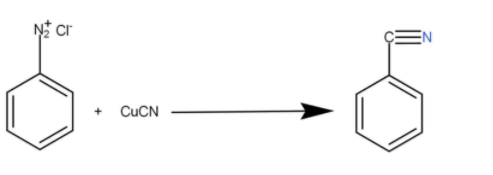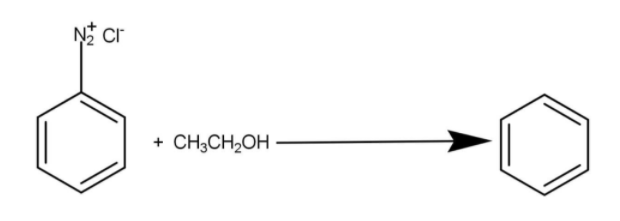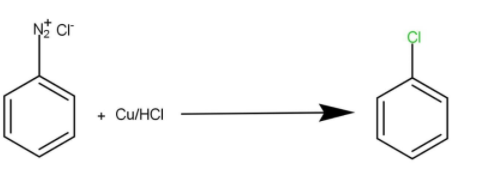
Write the structure of the main products when benzene diazonium chloride reacts with the following reagents:
A.
B.
C.
Answer
453.3k+ views
Hint: Nucleophilic substitution reaction occurs in case of copper cyanide and copper plus hydrochloric acid on benzene ring. In reaction with alcohol the nitrogen gas will release out of the diazo molecule.
Complete step-by-step answer:Diazonium salts are colourless salts and are crystalline in nature. They are highly soluble in water. The general formula for the diazonium salt is
Reaction with copper cyanide:
There is an easy way for the formation of halo benzene from diazonium salts. The diazonium salt is treated with copper cyanide; the diazo group got replaced by the cyanide group. This reaction is commonly named as sandmeyer reaction. The reaction occurs as follow:

Reaction with ethanol:
Alcohol reacts with diazonium salts to form benzene and nitrogen gas is released along with the formation of ac acid and acetaldehyde. The reaction occurs as:

Reaction with copper and hydrochloric acid:
The diazo salts react with copper and hydrochloric acid to form chlorobenzene. This is also a nucleophilic substitution reaction. The reaction occurs as follow:

The major product formed is cyanobenzene, benzene and chlorobenzene respectively.
Note: The benzene diazonium salt is not very much stable hence it is not available commercially but can be prepared on demand. This compound is quite explosive and hence should be handled carefully. Diazonium coupling is used in the formation of Azo dyes which are used widely. There are many nucleophiles which can substitute the dinitrogen present in the diazo such as hydroxide, thiol and carboxylate groups.
Complete step-by-step answer:Diazonium salts are colourless salts and are crystalline in nature. They are highly soluble in water. The general formula for the diazonium salt is
Reaction with copper cyanide:
There is an easy way for the formation of halo benzene from diazonium salts. The diazonium salt is treated with copper cyanide; the diazo group got replaced by the cyanide group. This reaction is commonly named as sandmeyer reaction. The reaction occurs as follow:

Reaction with ethanol:
Alcohol reacts with diazonium salts to form benzene and nitrogen gas is released along with the formation of ac acid and acetaldehyde. The reaction occurs as:

Reaction with copper and hydrochloric acid:
The diazo salts react with copper and hydrochloric acid to form chlorobenzene. This is also a nucleophilic substitution reaction. The reaction occurs as follow:

The major product formed is cyanobenzene, benzene and chlorobenzene respectively.
Note: The benzene diazonium salt is not very much stable hence it is not available commercially but can be prepared on demand. This compound is quite explosive and hence should be handled carefully. Diazonium coupling is used in the formation of Azo dyes which are used widely. There are many nucleophiles which can substitute the dinitrogen present in the diazo such as hydroxide, thiol and carboxylate groups.
Latest Vedantu courses for you
Grade 11 Science PCM | CBSE | SCHOOL | English
CBSE (2025-26)
School Full course for CBSE students
₹41,848 per year
Recently Updated Pages
Master Class 9 General Knowledge: Engaging Questions & Answers for Success

Master Class 9 English: Engaging Questions & Answers for Success

Master Class 9 Science: Engaging Questions & Answers for Success

Master Class 9 Social Science: Engaging Questions & Answers for Success

Master Class 9 Maths: Engaging Questions & Answers for Success

Class 9 Question and Answer - Your Ultimate Solutions Guide

Trending doubts
Give 10 examples of unisexual and bisexual flowers

Draw a labelled sketch of the human eye class 12 physics CBSE

Differentiate between homogeneous and heterogeneous class 12 chemistry CBSE

Differentiate between insitu conservation and exsitu class 12 biology CBSE

What are the major means of transport Explain each class 12 social science CBSE

a Tabulate the differences in the characteristics of class 12 chemistry CBSE




